The Case Hardening process in Classic firearms
Many, but not all, gun enthusiasts are familiar with "case hardening," a metal treatment that creates beautiful color nuances, once widely used on muzzle-loading weapons and valuable, fine guns. Let's see why and how it was done then and now.
If you've ever seen a modern replica of a historic muzzle-loading weapon—a rifle, pistol, or revolver—you may have noticed that some components, such as the frame, action plate, or hammer, feature a surface finish with multicolored hues. This is known as "Case Hardening", a term used to describe a thermal-chemical cementation process that once treated the surface of certain key weapon components to harden and strengthen them.

The fully case hardened action of a Spencer Model 1860 carbine
Case hardening can create more or less vivid color hues on a metal surface, and its aesthetic value is what makes it so popular. But the real reason behind this process was essentially practical: to strengthen the metal.
Until the mid-19th century, in fact, firearm steels were much simpler and lower in carbon than today's steels, and before the introduction of the Bessemer process (1856), producing carbon steel was difficult, very expensive, and feasible only in small batches. Therefore, specific hardening heat treatments were only applied to the firearm components most subject to mechanical stress.
The main problem was that those heat treatments were not as accurate as today's heat treatments; they did not allow for such homogeneous treatment of the metal, with the result that the treated, carbon-enriched steel components became hard but also risked becoming brittle.
Some parts of the weapon, such as the revolver frame or the action and receiver of the rifle, had to be resistant to wear and tear, abrasion, and able to withstand heavy stress without breaking.
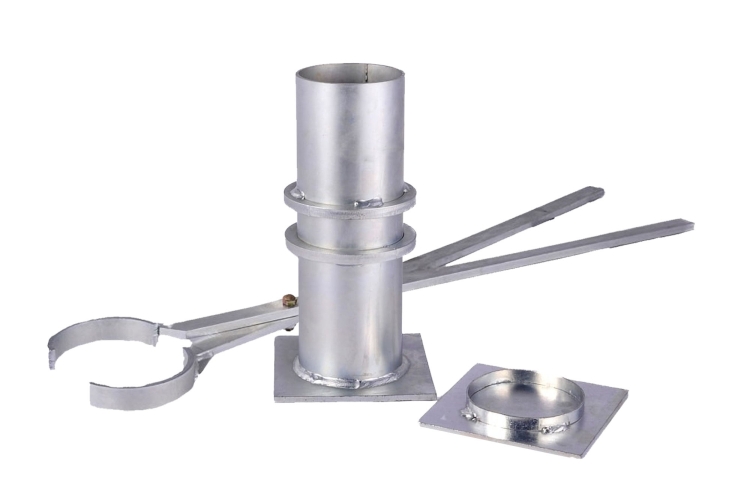
"Do It Yourself" Case Hardening: 28x10 cm container tube and pliers, sold by Brownells
(If you also bring home the forge and bellows, then you just have to explain it to your wife)
The best way to achieve these properties was by carburizing iron components on the surface only.
This treatment is called Case Hardening because the soft iron components to be treated were placed inside a sealed case, a metal or ceramic container, along with organic materials with a high carbon content, such as animal bones or animal bone charcoal. The sealed container was then kept for hours in a furnace at a temperature of approximately 700-760°C.
The purpose of the sealed container was to prevent oxygen from burning the carbon, allowing it to be absorbed by the metal, thus transforming the soft iron on the surface into steel. The number of hours in the furnace could be considerable (sometimes as long as 20 hours) and depended primarily on the type of metal and the size of the components being treated.

Case hardened components were typical on 18th century American rifles
Photo: case-hardened flintlock on a Pedersoli Frontier rifle
Case-hardened frames and hammers were characteristic of Colt revolvers of the 19th century
Photo: case-hardened frame and hammer on an Uberti 1873 Cattleman revolver
Depending on temperature and time, the carbon penetrates the iron to a depth of about 1.5 mm, effectively transforming the metal's surface from soft iron to steel.
Once removed from the container, the treated components, still red-hot, were immediately immersed in water, causing a thermal shock that quenched them and hardened the metal's surface.
The result is an iron component with a harder outer surface that is more resistant to wear and oxidation, while the inner core remains resilient, better able to withstand heavy stresses without breaking.
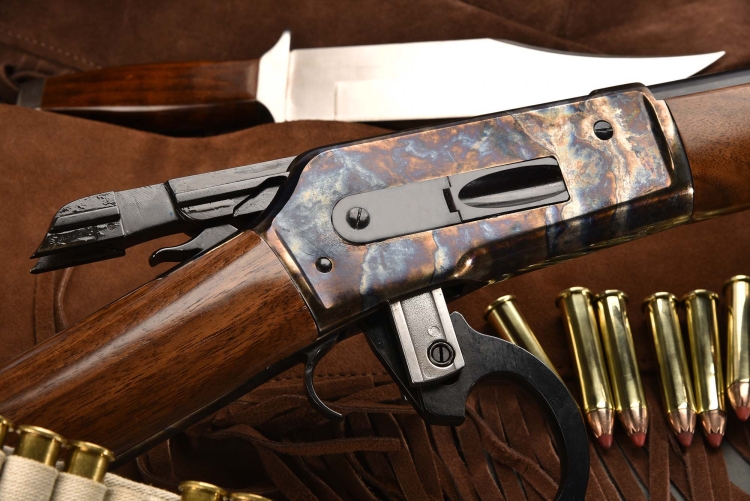
The beautiful case hardening of the Pedersoli Winchester 1886 replica
Read the article on the Pedersoli 1886 Sporting Classic Rifle...
However, many things can go wrong and compromise the final aesthetic quality of the components.
To avoid problems, the iron components to be treated had to be religiously cleaned before being placed in the container: any trace of grease would cause unsightly streaks and stains in the colors, rather than the beautiful, soft swirls so sought after. Organic materials, on the other hand, finely ground to the desired grain, had to be carefully mixed. The parts to be treated then had to be perfectly enveloped in the case hardening medium inside the container.
It was precisely in the care taken during the preparation phase that the skill, experience, and mastery of the craftsman were revealed, which ultimately determined the "chromatic beauty" of the finished piece. All these precautions were as valid then as they are today, for anyone wishing to experiment with these treatments on their own.

The case hardening on the frame, hammer, and loading lever was a typical feature of all Colt percussion revolvers. Pictured is a rare, splendid pair of Colt 1851 Navy models donated (probably 1855) by King Vittorio Emanuele II of Italy to General Alessandro Negri di Sanfront.
Like alchemists, artisans often added other organic materials to the bone charcoal: for example, charcoal, or stuff like horse hoof scraps, leather (old leather was sometimes considered superior to new), and even horse urine (also used in the browning process for gun barrels) because it was believed to produce better colors. This entire mixture, however, had to be ground and mixed.
After the heat treatment described above, in addition to the carbon, the metal surface absorbed—in a completely irregular and unpredictable way—other chemicals contained in the mixture of bone and wood charcoal powder and other organic substances in which the parts were immersed, revealing the beautiful swirls of color typical of tortoiseshell.
If you add together the time, the skill required to perform the treatment, and the possibility of ruining or destroying a component, it's easy to understand why this treatment was expensive.
So far, this is how things used to be done.
Case Hardening, today
The heat treatment we have described, which case hardened the metal and achieved the coloring effect, was and remains a substantially artisanal process, which any gunsmith can still use today, but which is not suitable for industrial use, because it cannot be applied in a practical and controllable way to a large number of components at the same time.
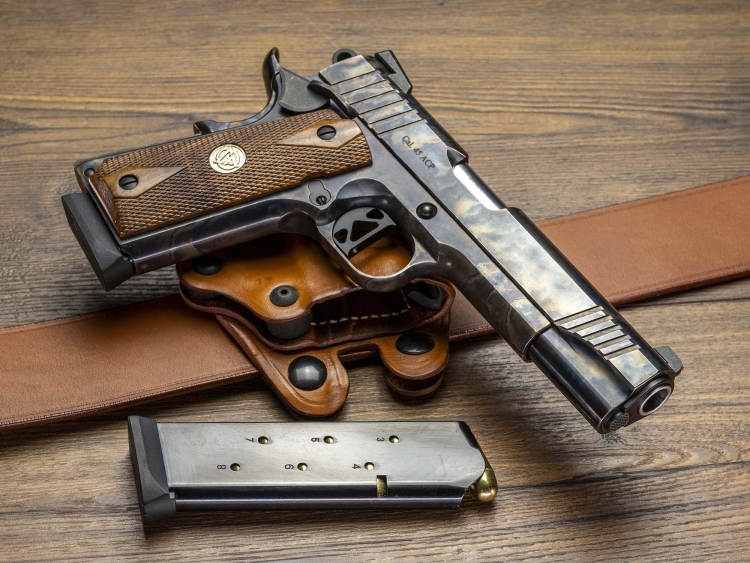
Chiappa Firearms 1911-45 Superior "Color Case" Pistol
For this reason, modern gunsmiths who use case hardening extensively, such as Uberti and Pedersoli, makers of excellent replicas of historical weapons, turn to specialized suppliers for case hardening. These suppliers employ industrial chemical processes in which the metal's carbon enrichment (case hardening) and the aesthetic effect of case hardening are achieved by immersing the parts in high-temperature baths of various types of salts.
Modern industrial processes for case hardening have used salt mixtures containing potassium or sodium cyanide, barium, and various nitrates, depending on the purpose. However, due to the high toxicity of these components, these mixtures have been replaced over the years by baths containing less dangerous but equally effective salts.
Many people criticize chemical case hardening as "a cheap process that produces poor-quality colors," which was also true a few decades ago, with the progressive implementation of bans on the use of particularly toxic substances and the need to find (literally) alternative solutions.
The following images show the sequence of steps typically used today to obtain case hardening on an industrial scale by immersion in a liquid mixture of salts at high temperatures and subsequent quenching in water.

The parts to be treated are mounted on a support attached to a steel rod

The parts to be treated are immersed in the high temperature liquid for a few minutes
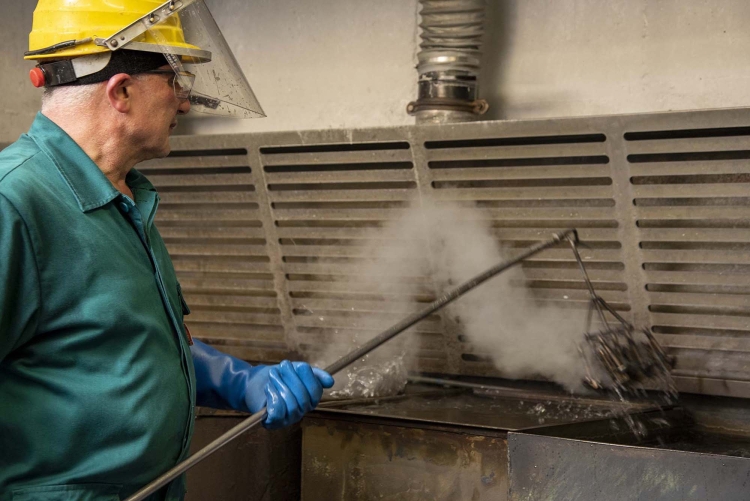
Once removed from the salt bath, the red-hot parts are thrown into water, tempering them
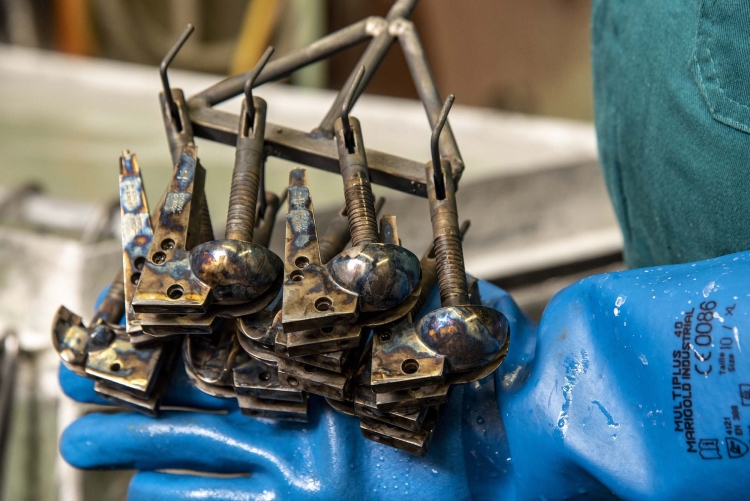
Once removed from the water and left to cool, the parts show the characteristic color case hardening texture
But making judgments without understanding the needs and limitations of steel metallurgy is unfair, for example, to manufacturers of replicas of historical weapons, who must produce case hardened components using modern processes at reasonable industrial costs, while still ensuring a beautiful aesthetic result.
In modern "chemical" case hardening, components are case-hardened in the same way as the bone charcoal method, with the same effect. The only difference is that the case hardening, the carbon enrichment, is not achieved using bone charcoal, but by immersion in a liquid bath containing specific salts and chemical elements.

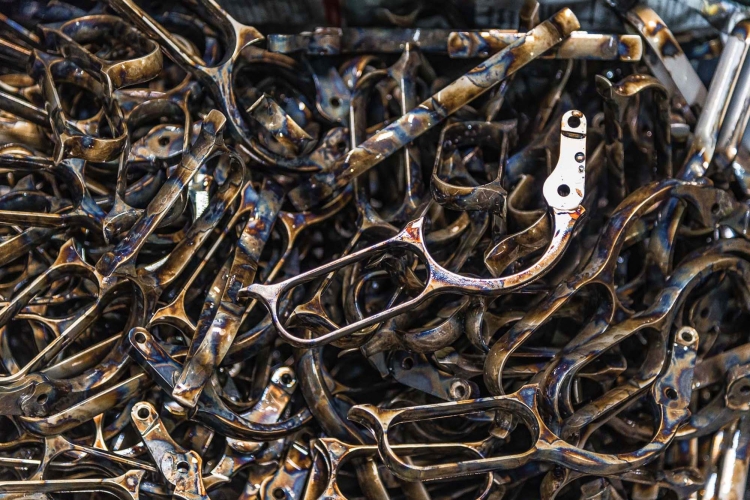

Even when done with modern techniques, case hardening continues to be present on many high-end hunting rifles.
But on the other hand, especially today, when discussing case hardening, there's an important distinction to make. A modern master restorer of antique weapons, using the traditional "color case hardening" method, can restore a fierearm to its original state, enhancing its case hardened components with profoundly beautiful colors and nuances. However, the steel content of weapons from the 19th and early 20th centuries was not comparable to that of modern steels, now also used on modern replicas of historical weapons.
Modern steels have far better mechanical properties, but the alloys they are composed of already contain the carbon necessary to make them resistant, and trying to case harden them using "bone charcoal" makes little sense.
Therefore, when discussing case hardening on components of weapons produced today at an industrial level, using modern steels,chemical case hardening is clearly more suitable, also because it's more controllable and chromatically homogeneous.
Assuming, therefore, that the mechanical properties of modern steels are superior to those of weapons of the past, a question often asked by enthusiasts is: are the colors obtained with chemical case hardening more superficial and more delicate than those obtained with traditional case hardening?
The answer is no.
Whether case hardening colors are bright or subtle depends on the type of steel being treated and the chemicals used in the case hardening process, just as was the case with the organic additives used in the past. Whether traditional or chemical case hardening, the colors on the metal are surface only, as they are a byproduct of the interaction bewteen metal surface, case hardening medium and bubbles in water during quenching, but with modern case hardening processes, the bonding of colors is more durable than the traditional methods used in past centuries.

Pair of Uberti Colt revolvers: an 1873 Single Action Army and an 1894 Bisley, with case hardened frames in shades closer to the originals
Just like today, the problem of having to industrially produce many case hardened components was also faced by 19th-century manufacturers, such as Colt: on whose revolvers, both muzzle-loading and breech-loading, the color tones of the case hardening on the receivers and hammers were never bright, but rather, often rather nuanced in shades of brown and gray, and also rather superficial, so much so that they are often no longer even visible today, on the original period items that have survived to this day.

A nice Smith & Wesson Model 10 with a case hardened frame
Photo: Turnbull Restoration
Today, manufacturers and restorers sometimes use varnishes or lacquers to protect the colors, up to high-tech treatments like MC-160 High Gloss Ceramic Clear Cerakote, which offers a high level of protection for treated surfaces.
When it comes to color nuances, the most chromatically beautiful color casehardenings of the last two hundred years are found primarily on fine hunting rifles made by famous gunsmiths, mostly English and American, who worked on a limited number of casehardened components at a time.
But in conclusion: with modern "chemical" casehardening, it is possible to achieve vibrant and interesting colors like the old bone charcoal casehardening, with all the added advantages of the mechanical properties of modern steels in terms of durability, consistent quality, and safety.
As demonstrated by the photos of some modern replicas of historic Uberti and Pedersoli weapons shown in this article.

Modern replicas of historic weapons. From top: Spencer 1860 carbine (Chiappa), Sharps 1874 carbine (Pedersoli), Winchester 1873 Short Rifle (Uberti)

Modern Uberti replicas of American revolvers. From top: Colt Dragoon 3rd Model, Colt 1851 Navy, Colt 1873 Single Action Army, Remington 1875





